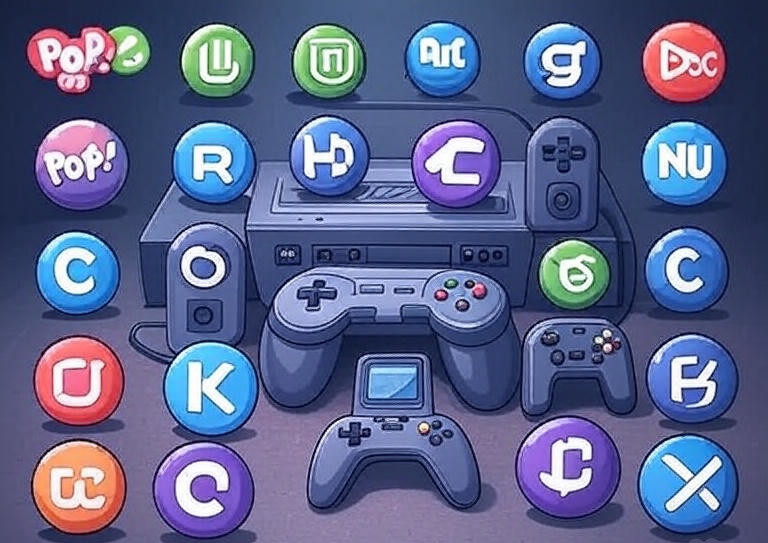
Top 15 Linux Distros for Gaming in 2025
Linux has solidified its place as a viable gaming platform in 2025, with advancements in Proton, Vulkan, and native game support making it a compelling alternative to Windows. The right Linux distribution can make or break your gaming experience, offering tailored optimizations, pre-installed tools, and hardware compatibility. Below is a comprehensive list of the top 15 Linux distros optimized for gaming in 2025, covering a range of use cases from modern AAA titles to retro emulation and handheld gaming.
1. Pop!_OS
Developed by System76, Pop!_OS is a Ubuntu-based distro with a focus on simplicity and performance. Its COSMIC desktop (now Rust-based) is lightweight and responsive, and it offers separate ISO images for AMD and NVIDIA GPUs with proprietary drivers pre-installed, ensuring optimal performance. Pop!_OS integrates seamlessly with Steam, Lutris, and Proton, making it ideal for gamers who also need a productive workstation.
- Why it’s great: Out-of-the-box GPU support, streamlined interface, and excellent Proton compatibility.
- Best for: Gamers with NVIDIA GPUs and those who want a balance of gaming and productivity.
- Downsides: Limited desktop environment customization compared to others.
2. Nobara Linux
Nobara, a Fedora-based distro by GloriousEggroll (Proton-GE developer), is built for gaming and content creation. It includes pre-installed tools like Steam, Proton-GE, Lutris, and OBS Studio, with kernel tweaks and custom patches for low latency and high FPS. Nobara supports both desktop and handheld devices, making it versatile for various gaming setups.
- Why it’s great: Gaming-specific optimizations and pre-configured tools.
- Best for: Competitive gamers and streamers seeking cutting-edge performance.
- Downsides: Fedora’s bleeding-edge updates may introduce occasional instability.
3. Garuda Linux
Garuda Linux, an Arch-based distro, is a performance beast with a visually stunning KDE Plasma desktop (Dr460nized edition). It uses the Zen kernel for gaming optimization and includes tools like Garuda Gamer for easy installation of Steam, Lutris, and Wine. Btrfs snapshots provide a safety net for system tweaks, making it ideal for enthusiasts.
- Why it’s great: Zen kernel, gaming tools, and a highly customizable interface.
- Best for: Gamers who love Arch’s rolling updates and deep customization.
- Downsides: Steeper learning curve for Linux novices.
4. SteamOS 3 (HoloISO)
SteamOS 3, Valve’s Arch-based OS for the Steam Deck, is available for PCs via HoloISO. It’s designed for a console-like experience with Steam’s Big Picture Mode and Proton integration for near-perfect Windows game compatibility. Its immutable filesystem ensures stability, and it’s optimized for both desktop and handheld gaming.
- Why it’s great: Seamless Steam integration and Proton performance.
- Best for: Steam Deck fans or those wanting a living-room gaming setup.
- Downsides: Limited to Steam-centric gaming without additional setup.
5. Linux Mint
Linux Mint, a Ubuntu-based distro, is beginner-friendly with its lightweight Cinnamon desktop. While not gaming-specific, it’s stable and supports gaming tools like Steam, Lutris, and Wine with minimal setup. Its vast community and Ubuntu compatibility make it easy to troubleshoot and optimize for gaming.
- Why it’s great: Stable, user-friendly, and versatile for mixed-use systems.
- Best for: Newcomers to Linux or casual gamers.
- Downsides: Requires manual tweaks for optimal gaming performance.
6. Manjaro
Manjaro, an Arch-based distro, balances cutting-edge software with ease of use. Its rolling-release model ensures the latest drivers and gaming tools via the Arch User Repository (AUR). The KDE Plasma desktop is customizable and gaming-friendly, making Manjaro a solid choice for performance and flexibility.
- Why it’s great: Access to AUR, latest drivers, and a polished interface.
- Best for: Gamers who want Arch’s power with a user-friendly setup.
- Downsides: Rolling updates can occasionally cause issues.
7. Drauger OS
Drauger OS is a Ubuntu-based distro designed specifically for gaming. It features a custom low-latency kernel, pre-installed tools (Steam, Lutris, Wine), and GameMode for resource optimization. Its KDE Plasma desktop is lightweight, ensuring high frame rates and minimal screen tearing.
- Why it’s great: Gaming-focused kernel and pre-installed tools.
- Best for: Performance-focused gamers on a budget.
- Downsides: Smaller community means less support compared to Ubuntu.
8. Fedora Games Spin
Fedora Games Spin is a Fedora variant pre-loaded with open-source games and Wayland support for smooth performance. While it requires manual installation of proprietary drivers for serious gaming, its stability and regular updates make it a reliable choice for retro and casual gaming.
- Why it’s great: Open-source game collection and Wayland support.
- Best for: Open-source enthusiasts and retro gamers.
- Downsides: Lacks pre-installed proprietary gaming tools.
9. Lakka
Lakka, built on RetroArch, transforms your PC into a retro gaming console. It supports emulators for classic consoles like NES, SNES, and Sega Genesis. Lightweight and easy to set up, Lakka is perfect for reliving childhood games with automatic joypad recognition and netplay features.
- Why it’s great: Lightweight and emulator-focused for retro gaming.
- Best for: Retro gaming enthusiasts.
- Downsides: Not suited for modern AAA titles.
10. Batocera.linux
Batocera is an independent distro designed for retro gaming, turning any PC into a gaming console. It supports a wide range of emulators and comes with a user-friendly interface for managing games. It’s ideal for both desktop and handheld retro gaming setups.
- Why it’s great: Extensive emulator support and plug-and-play setup.
- Best for: Retro gamers with varied hardware.
- Downsides: Limited to emulation, not modern gaming.
11. Bazzite
Bazzite, a Fedora Atomic-based distro, is optimized for both PCs and handheld devices like the Steam Deck, ASUS ROG Ally, and Lenovo Legion Go. It comes with Steam pre-installed and supports games from multiple stores (Epic, GOG, etc.), making it a versatile gaming platform.
- Why it’s great: Handheld and desktop support with broad game compatibility.
- Best for: Handheld gamers and Steam Deck alternatives.
- Downsides: Less polished for non-Steam games.
12. CachyOS (Handheld Edition)
CachyOS, an Arch-based distro, offers a handheld edition optimized for devices like the Steam Deck and ASUS ROG Ally. Its performance-focused design includes a custom kernel and gaming tweaks, making it a rising star for portable gaming.
- Why it’s great: High performance for handheld gaming.
- Best for: Arch enthusiasts with gaming handhelds.
- Downsides: Requires some technical knowledge for setup.
13. ChimeraOS
ChimeraOS turns your PC into a Steam-powered console, supporting controllers and games from Steam, Epic, and GOG. It’s designed for desktop gaming with a console-like experience but isn’t suited for handhelds. Its focus on simplicity makes setup a breeze.
- Why it’s great: Console-like experience with multi-store support.
- Best for: Living-room PC gamers.
- Downsides: Not optimized for handheld devices.
14. Regata OS
Regata OS, based on openSUSE, is a general-purpose distro with strong gaming optimizations. It supports AMD and NVIDIA GPUs with Vulkan and AMD FSR built-in. Regata OS Game Access simplifies playing games from Steam, Epic, and other platforms.
- Why it’s great: Broad GPU support and multi-platform game access.
- Best for: Gamers seeking openSUSE’s stability with gaming tweaks.
- Downsides: Smaller community compared to Ubuntu-based distros.
15. Sparky Linux GameOver Edition
Sparky Linux GameOver Edition is a lightweight, Debian-based distro with tools for both retro and modern gaming. It includes Steam, Wine, PlayOnLinux, and emulation software, making it versatile for older hardware while supporting modern titles.
- Why it’s great: Lightweight with broad gaming tool support.
- Best for: Gamers with older PCs or retro gaming interests.
- Downsides: Requires more manual configuration for modern games.
Key Trends in Linux Gaming for 2025
- Proton 10: Valve’s Proton continues to improve, with expected 2025 updates enhancing compatibility for AAA titles.
- Vulkan API: Dominates Linux gaming for low-overhead performance on AMD and NVIDIA GPUs.
- Handheld Gaming: Distros like Bazzite, CachyOS, and SteamOS cater to the growing popularity of handheld devices like the Steam Deck.
- Community Tools: Lutris, Heroic Games Launcher, and Bottles simplify managing games from non-Steam platforms.
Choosing the Right Distro
- Beginners: Linux Mint, Ubuntu, or Pop!_OS for ease of use.
- Performance Enthusiasts: Nobara, Garuda, or CachyOS for optimized kernels and drivers.
- Handheld Gamers: SteamOS, Bazzite, or CachyOS Handheld Edition.
- Retro Gamers: Lakka, Batocera, or Sparky Linux GameOver Edition.
- Console-Like Experience: SteamOS or ChimeraOS.
Check your hardware (especially GPU compatibility), gaming platform preferences, and Linux experience level. Most distros support Proton, but NVIDIA users should prioritize distros with pre-installed proprietary drivers (e.g., Pop!_OS, Nobara). For specific game performance, consult ProtonDB or community forums.
Conclusion
Linux gaming in 2025 offers something for every gamer, from casual players to retro enthusiasts and handheld warriors. With distros like Pop!_OS, Nobara, and SteamOS leading the charge, Linux is no longer a niche gaming platform. Pick a distro, tweak your setup, and enjoy a free, open-source gaming experience!


